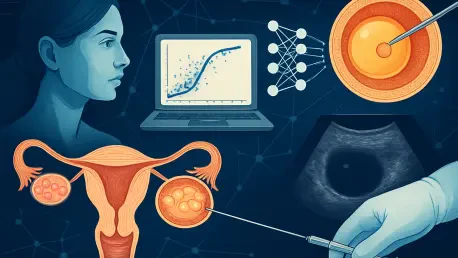In recent years, the field of assisted reproductive technology (ART) has witnessed remarkable developments, including efforts to optimize oocyte retrieval timing to improve overall outcomes. A pivotal area of exploration has been developing a data-driven predictive model that informs the ideal timing for oocyte retrieval. Utilizing this approach aims to maximize the yield of mature oocytes, a critical factor in enhancing success rates during ART cycles. A groundbreaking study has been conducted, analyzing an extensive dataset comprising 49,961 oocyte pickup cycles to identify and understand the key determinants influencing oocyte retrieval timing.
Understanding the Complexities of Oocyte Retrieval Timing
The Impact of Individual Variables
The pursuit of optimizing the timing for oocyte retrieval has unveiled the complexities involved in the process, which are influenced by a plethora of patient-specific factors. Central to these factors are variables like female age, antral follicle count (AFC), and the controlled ovarian hyperstimulation (COH) protocol in use. Each of these variables plays a decisive role, influencing not only the response to hormonal treatment but also the timing required for optimal oocyte maturation. In addition to these, the number of follicles larger than 14 mm on the trigger day offers insight into the patient’s response to stimulation.
Moreover, hormonal levels—often represented by E2, P, and LH on the ovulation trigger day—further complicate the timing considerations. These hormonal indicators serve as crucial benchmarks for timing decisions, reflecting the physiological readiness for retrieval. However, disparate responses to these hormonal cues mean that a one-size-fits-all approach may not cater to the nuanced needs of every individual, underscoring the necessity for a tailored, patient-centric approach.
Analytical Tools and Their Contributions
Diving deeper into the intricacies of oocyte retrieval timing, multiple analytical methods have proven invaluable in deciphering complex data patterns and isolating key influencing factors. Techniques such as multiple linear regression (MLR) and directed acyclic graphs (DAG) have provided a framework for evaluating the interactions and influences at play. These statistical tools allow researchers to draw predictive correlations and formulate mathematical models that simulate the timing of oocyte retrieval.
The derived mathematical formula, based on highlighted determinants, offers a predictive capacity, enabling healthcare practitioners to fine-tune treatment schedules. Armed with these insights, ART professionals can approach each cycle with an individualized plan, increasing the likelihood of extracting mature oocytes efficiently. By leveraging predictive modeling, ART clinicians can transcend conventional timing methods, aiming towards a future of precision medicine where outcomes improve through personalized interventions.
A Shift Towards Personalized Medicine in ART
Moving Beyond Fixed Schedules
The study acknowledges the prevalent dependence on fixed schedules for oocyte retrieval, historically dictated by generic guidelines. Traditional protocols often recommended retrieval within a 32–36-hour window post-hormonal trigger. While this offers a standardized approach, it may not adequately address patient-specific variability. Fixed schedules lack flexibility, ignoring individual differences that can be pivotal in optimizing results. In embracing the transition toward personalized medicine, ART practitioners are recognizing the importance of adopting schedule adjustments based on comprehensive evaluations of patient-specific factors.
This shift in thinking aligns with the ongoing trend towards personalized medicine, emphasizing tailor-made treatment frameworks for optimum results. By recalibrating timing schedules to cater to unique physiological responses, ART clinicians can achieve better precision and enhance success rates. This paradigm shift marks a significant departure from tradition and sets a new precedent for excellence in patient care within reproductive medicine.
Evaluating Past Research and Emerging Trends
Exploring previous research reveals earlier studies alluding to the variability of retrieval timing across different COH protocols. Mild protocols, antagonist protocols, and PPOS (progestin-primed ovarian stimulation) protocols each suggest variations in optimal hormonal administration. For instance, differently tailored retrieval times based on specific protocols can potentially enhance the maturity and quality of retrieved oocytes. Such insights confirm the necessity of veering away from rigid timing concepts, instead advocating for adaptable strategies that accommodate specific protocols and enhance effectiveness.
The consensus among researchers highlights the urgency of integrating flexible methods, making space for innovation in ART practices. These adaptable strategies recognize the fluid nature of biological variables and provide room for advancements in reproductive technologies. By fostering an environment that prioritizes breakthrough research, ART can evolve progressively, paving the way for greater successes in fertility treatments.
Key Determinants and the Call for Further Validation
Prioritizing Influential Factors
At the core of the study’s findings are the specific determinants that play crucial roles in the timing and success of oocyte retrieval. Factors such as age, AFC, COH protocol specifics, follicular count on the trigger day, and hormonal levels collectively contribute to shaping a successful retrieval schedule. The research emphasizes quantifying the influence each factor holds, presenting a structured hierarchy that begins with a predominant focus on COH regimens. It further suggests the weightage diminishes progressively through hormone levels, advancing towards age and antral follicle count.
Such prioritization makes it clear which variables require closer attention when formulating personalized schedules. It offers ART practitioners a roadmap for decision-making, channeling resource allocation and monitoring efforts where most effective. Nonetheless, the innovation and promise encapsulated in the predictive model are not without room for improvement, as the synthesized model achieved an R2 value of 0.31, indicating moderate explanatory power.
A Path Forward: External Validations
Despite its promising prospects, the predictive model necessitates external validation and refinement. Expansion is essential to account for diversity in populations and clinical settings, ensuring the model’s effectiveness across different scenarios. Acknowledging the study’s limitations in being confined to a singular clinical environment, the necessity for additional research collaborations becomes evident. By corroborating outcomes across varied populations and practices, the generalized applicability of the model will be strengthened, driving ART progress towards universal relevance.
The strengthened model, driven by collective insights and multidisciplinary collaborations, promises enhanced precision and efficacy in ART outcomes. Offering transformative potential, it sets the stage for more comprehensive healthcare approaches, fostering pathways for adaptation and optimization within reproductive medicine.
Future Perspectives and Innovations
Recently, the field of assisted reproductive technology (ART) has experienced significant advancements, particularly in optimizing the timing of oocyte retrieval to enhance outcomes. A key focus has been creating a data-driven predictive model to determine the best timing for this procedure. The objective is to maximize the harvest of mature oocytes, which is crucial for boosting success rates in ART cycles.
One of the groundbreaking studies undertaken in this realm involved analyzing a vast dataset of 49,961 oocyte pickup cycles. The purpose was to identify and comprehend the primary factors influencing the timing of oocyte retrieval. By understanding these factors, scientists aim to refine strategies that could significantly improve the efficiency and effectiveness of assisted reproductive treatments.
The ability to predict the ideal timing for oocyte retrieval can potentially lead to better outcomes for individuals undergoing ART. It ensures that the highest possible number of mature oocytes are collected, thereby increasing the likelihood of successful fertilization and pregnancy. This study not only highlights the potential of data analytics in enhancing ART processes but also sets the stage for future research that could further revolutionize fertility treatments. By examining such extensive data, researchers are paving the way for more personalized and effective approaches to tackling infertility issues.









